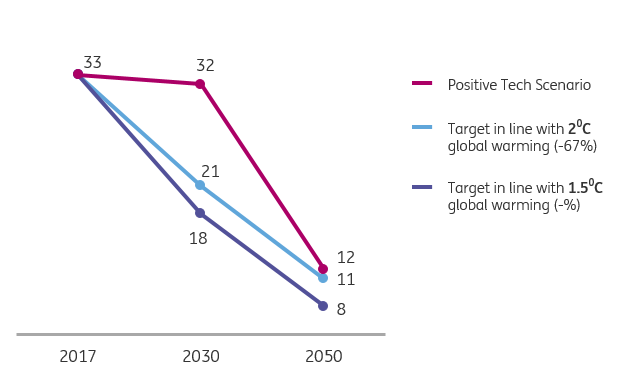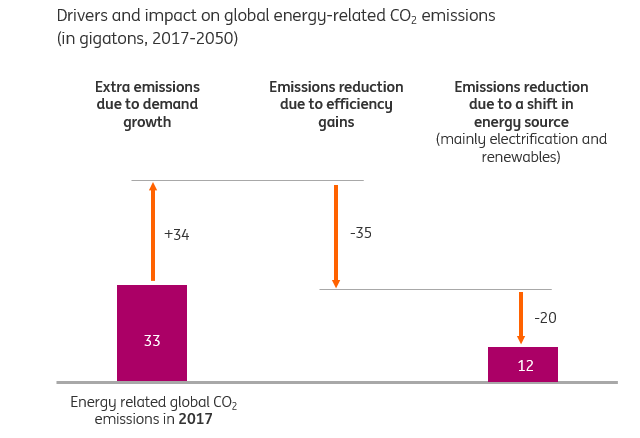Can technology be the climate saviour?
Technology could reduce energy-related CO2 emissions by 64% globally. But by how much and when? The basics from our major new report that you can download here
How technology can help
Technology could reduce energy-related CO2 emissions by 64% globally. This is close to the emissions reduction targets of 2050, but the 2030 targets are missed. It will take time for new technologies to be implemented, while in the meantime the global economy continues to grow.
ING has analysed technological developments in energy-intensive sectors. The report addresses technologies for energy efficiency, electrification and renewables, and presents ING’s ‘Positive Tech Scenario’. The Paris Agreement climate targets for 2030 will be missed, but technology can reduce energy-related carbon emissions from 33 gigatons to 12 by 2050 (-64%) As such, technology can deliver a low carbon economy towards that date.
Positive Tech scenarios: A slow start but huge reductions by 2050
Global energy-related CO2 emissions (gigatons)

Technology has significant potential
ING’s Positive Tech Scenario allows for continued economic growth, absorbs increases in the global population and aspirational middle classes. These trends could increase energy-related emissions by 34 gigatons. Energy efficiency reduces emissions by 35 gigatons. Electrification and a shift towards renewables add another 20 gigatons.
Many green technologies initially require government policies to become cost competitive and achieve scale. A less emphasised need for policy is to correct unintended feedback loops. For instance, while the switch to electric vehicles is expected to reduce demand for oil, this could cause the oil price to fall and spur demand from shipping and aviation. Strong policy (regulation, subsidies and most of all carbon pricing) is required to eliminate these side-effects. Policy coordination at a global level is most effective.
Positive Tech Scenario: Efficiency gains and a shift to renewables are key

Key pillars of ING’s Positive Tech Scenario:
• By 2040 all cars sold will be fully electric
• By 2050 the car fleet will be fully electric, 65% of the truck fleet and 10% of shipping fleet (including hybrid vessels)
• Electricity will be the main energy source in the real estate and industrial sectors
• Innovation will trigger further electrification in the transport, real estate and industrial sectors. Power demand will increase by 160% (to 52,000 Twh from 20,000 Twh currently).
• By 2050, electricity will be almost entirely generated by renewable energy, with 66% of wind and solar energy, compared to 6% today.
• Power generation from nuclear energy rises marginally, its share in the global power mix declines from 11% now to 5% in 2050
Download the full report by clicking on this link
This publication has been prepared by ING solely for information purposes irrespective of a particular user's means, financial situation or investment objectives. The information does not constitute investment recommendation, and nor is it investment, legal or tax advice or an offer or solicitation to purchase or sell any financial instrument. Read more
Download
Download article